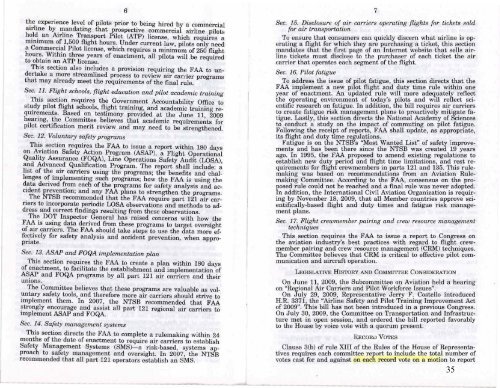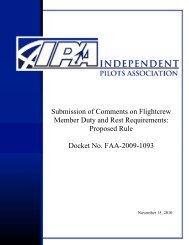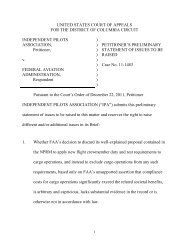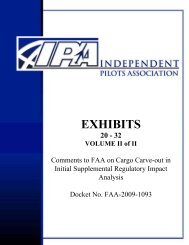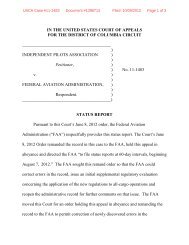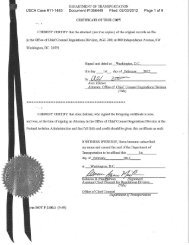Brief Addendum - Independent Pilots Association
Brief Addendum - Independent Pilots Association
Brief Addendum - Independent Pilots Association
You also want an ePaper? Increase the reach of your titles
YUMPU automatically turns print PDFs into web optimized ePapers that Google loves.
6<br />
tl,Ie .experience leve! of pilots prior to being hired by a commercial<br />
airlIne by. ~andatmg that ~rospective commercial airline pilots<br />
h~l~ an Airlme Tr~nsport PIlot (ATP) license, which requires a<br />
mmlmum o~ 1,5~0 fl~ght hours.. Under current law, pilots only need<br />
a Comme!cI~1 PIlot lIcense, whIch requires a minimum of 250 flight<br />
hours..Wlthm thr~e years of enactment, all pilots will. be required<br />
to obtam an ATP lIcense.<br />
This section also includes a provision requiring the FAA to undertake<br />
a more streamlined process to review air carrier programs<br />
that may already meet the requirements of the final rule.<br />
Sec. 11. Flight schools, flight education and pilot academic training<br />
This .secti~n requires the Government Accountability Office to<br />
st~dy pIlot flIght schools, flight training, and academic training reqUIrements.<br />
Based on testimony provided at the June 11 2009<br />
h~aring, ~he C;ommitt.ee believes that academic requireme~ts for<br />
pIlot certIficatIOn ment review and may need to be strengthened.<br />
Sec. 12. Voluntary safety programs<br />
This. s~ction requires.the FAA to issue a report within 180 days<br />
on A:'latIOn Safety ActIOn Program (ASAP), a Flight Operational<br />
QualIty Assurance (FOQA), Line Operations Safety Audit (LOSA)<br />
~nd Advanc~d Qu~lification Program. The report shall include: ~<br />
lIst of the. all' carne!s using the programs; the benefits and challenges<br />
o~ Implementmg such programs; how the FAA is using the<br />
d.ata denved f~om each of the programs for safety analysis and ac<br />
CIdent preventIOn; and any FAA plans to strengthen the programs.<br />
. The ~TSB recommended that the FAA require part 121 air carners<br />
to mcorporate periodic LOSA observations and methods to address<br />
and correct findings resulting from these observations.<br />
The DOT Inspector General has raised concerns with how the<br />
FAA is using data derived from these programs to target oversight<br />
of a~r carriers. The FAA should take steps to use the data more effe~tlVely<br />
for safety analysis and accident prevention, when appropnate.<br />
Sec. 13. ASAP and FOQA implementation plan<br />
This section requ~r.es the FAA to create a plan within 180 days<br />
of enactment, to faclhtate the establishment and implementation of<br />
ASAP and FOQA programs by all part 121 air carriers and their<br />
unions.<br />
The Committee believes that these programs are valuable as voluntary<br />
safety tools, and therefore more air carriers should strive to<br />
implement them. In 2007, the NTSB recommended that FAA<br />
~trongly encourage and assist all part 121 regional air carriers to<br />
Implement ASAP and FOQA.<br />
Sec. 14. Safety management systems<br />
This section directs the FAA to complete a rulemaking within 24<br />
months of the date of enactment to require air carriers to establish<br />
Safety Management Systems (SMS)-a risk-based, systems approach<br />
to safety management and oversight. In 2007, the NTSB<br />
recommended that all part 121 operators establish an SMS.<br />
7<br />
Sec. 15. Disclosure of air carriers operating flights for tickets sold<br />
for air transportation<br />
To ensure that consumers can quickly discern what airline is operating<br />
a flight for which they are purchasing a ticket, this section<br />
mandates that the first page of an Internet website that sells airline<br />
tickets must disclose to the purchaser of each ticket the air<br />
carrier that operates each segment of the flight.<br />
Sec. 16. Pilot fatigue<br />
To address the issue of pilot fatigue, this section directs that the<br />
FAA implement a new pilot flight and duty time rule within one<br />
year of enactment. An updated rule will more adequately reflect<br />
the operating environment of today's pilots and will reflect scientific<br />
research on fatigue. In addition, the bill requires air carriers<br />
to create fatigue risk management plans to proactively mitigate fatigue.<br />
Lastly, this section directs the National Academy of Sciences<br />
to conduct a study on the impact of commuting on pilot fatigue.<br />
Following the receipt of reports, FAA shall update, as appropriate,<br />
its flight and duty time regulations.<br />
Fatigue is on the NTSB's "Most Wanted List" of safety improvements<br />
and has been there since the NTSB was created 19 years<br />
ago. In 1995, the FAA proposed to amend existing regulations to<br />
establish new duty period and flight time limitations, and rest requirements<br />
for flight crewmembers in parts 121 and 135. This rulemaking<br />
was based on recommendations from an Aviation Rulemaking<br />
Committee. According to the FAA, consensus on the proposed<br />
rule could not be reached and a final rule was never adopted.<br />
In addition, the International Civil Aviation Organization is requiring<br />
by November 18, 2009, that all Member countries approve scientifically-based<br />
flight and duty times and fatigue risk management<br />
plans.<br />
Sec. 17. Flight crewmember pairing and crew resource management<br />
techniques<br />
This section requires the FAA to issue a report to Congress on<br />
the aviation industry's best practices with regard to flight crewmember<br />
pairing and crew resource management (CRM) techniques.<br />
The Committee believes that CRM is critical to effective pilot communication<br />
and aircraft operation.<br />
LEGISLATIVE HISTORY AND COMMITTEE CONtiIDERATION<br />
On June 11, 2009, the Subcommittee on Aviation held a hearing<br />
on "Regional Air Carriers and Pilot Workforce Issues".<br />
On July 29, 2009, Representative Jerry F. Costello introduced<br />
H.R. 3371, the "Airline Safety and Pilot Training Improvement Act<br />
of 2009". This bill has not been introduced in a previous Congress.<br />
On July 30, 2009, the Committee on Transportation and Infrastructure<br />
met in open session, and ordered the bill reported favorably<br />
to the House by voice vote with a quorum present.<br />
RECORD VOTES<br />
Clause 3(b) of rule XIII of the Rules of the House of Representatives<br />
requires each committee report to include the total number of<br />
votes cast for and against on each record vote on a motion to report<br />
.........................................................................................·· ······..·· ~ " 1" """"""" ~ L ..<br />
35


